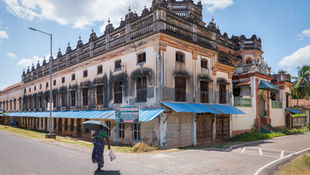The photographic recording should be done for posterity. Photographing a historic building must aim to convey information about it. It may be obscured in a photograph that attempts to convey the atmosphere. It can also express artistry through a distorted idea. At the same time, the photograph must be simple and should not compromise on clarity. The surrounding landscape should be considered while photographing. Modern elements such as neighbouring buildings and street lights must be avoided in the photograph. A wide-angle lens can be used. Whereas, to capture the details, a telephoto lens should be used. Thus, extra effort must be put into capturing even the simplest of exterior details, and the photographed elevation should give clues to the original or present internal room arrangement.
List of Contents
8) Conclusion
Techniques for Photographing Ceilings and Photographing Ceiling Details
A photographic record can be valuable when decorative architectural features need to be moved elsewhere. The ceiling can be photographed by placing the camera on the floor, on its back. Particular care has to be taken in levelling the camera to ensure that the plane of the film is parallel to the ceiling.

Reflections from a painted ceiling can be avoided by pointing the camera away from that end of the room, which is the source of both natural and artificial light. Illumination for low-relief cornices should be placed near the ceiling.

Reflected daylight or diffused illumination will show all parts of the white-painted high relief in detail. At the same time, overexposure should be avoided when photographing the building. When there is a high contrast between a low ceiling and the sidelight from a window, newspaper can be spread on the floor to reflect light.
Capturing Construction Details
The various forms of beam dumps can be lit in different ways; they should be in sharp focus and lit to show the shadow or highlight on the front cut-edge across the angle of the beam. A viewpoint from the underside of the beam shows that both are effective only when the carved decoration extends beyond the beam dump.


In timberwork, photography can record only limited information about constructional joints, for example, the position of pegs or wedges or the profile of the cuts.
Peg holes, joint breaks, separate pieces of timber, and stops should be visible in the photograph.

Photographing Doors
The best angle for lighting a closed door is usually 45 degrees to the plane of its surface. To prevent the convergence of verticals, the camera should be brought to the same level as the door's midpoint. A fireplace should be photographed from a similar position.




Dates and Inscriptions
Dates must be recorded both with the camera and in the notebook, as they may have to be searched further. Side-lighting is the best illumination if inscriptions project from the surface. When the date is at a higher point on the exterior, wait for the sun to reach the correct angle for photography
The essence of a photographic record of an inscription is that the words should be, as far as possible, legible. This can be achieved through careful lighting and a well-chosen camera position. Often, however, especially in the slightly damp atmosphere, condensation encourages the formation of a layer of dirt on the various fittings, which can obscure the inscription. By gently wiping the surface of, for example, a stone with a soft cloth and nothing else, the moisture may be removed. Except in an emergency, however, touching any art object is to be avoided. Advice regarding handling should always be sought from a trained conservator. If in doubt, do not touch.

The Aesthetics of All-White Subjects
Photographing an all-white subject is the most challenging photographic problem. It is desirable to have control over both lighting and contrast while photographing such a scenario.
The Utilisation of the Right Lighting and Camera
Lighting should be arranged to illuminate its complexity rather than its simple aspect. The position of the light source should not be changed in the case of taking a consistent and comparative record between two photographs. Moreover, a static camera can retain the scale in both photographs.

Large Interior Photography
In addition to the existing lighting, large interiors require a higher amount of illumination. Large spaces can also be adequately represented in a smaller area where controlling the light is a lot easier.
Conclusion
As part of the documentation, all the exterior and interior areas of the building and site should be considered.
Every detail should be considered, which includes windows, doors, brackets, sunshades, etc.
When the details, such as a carving, are shown, one should be able to make out where it is coming from with more views.
Maximum informative detail of the building is to be seen in all areas.
When trees or other objects obscure the details, take additional photos to get the details.
Photographic documentation should be done at regular intervals.
A lot of attention should be given to details such as inscriptions, carvings, unusual features, etc.
The photographs should be sorted into proper folders with the date, location, etc., so that anybody can access the information.
Visit the links given below, to read some of our blogs:





















Comentarios